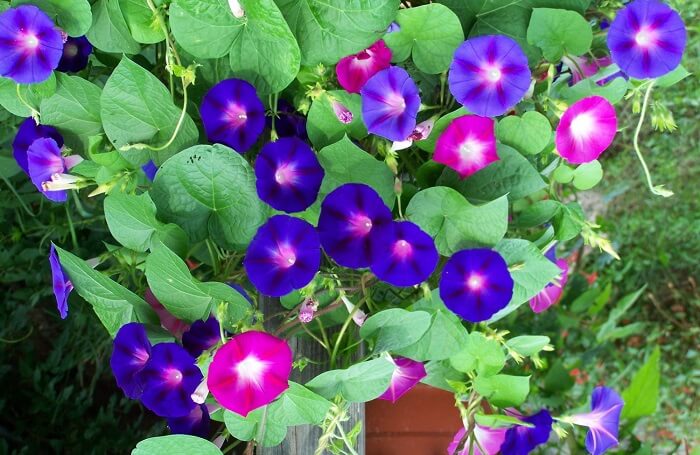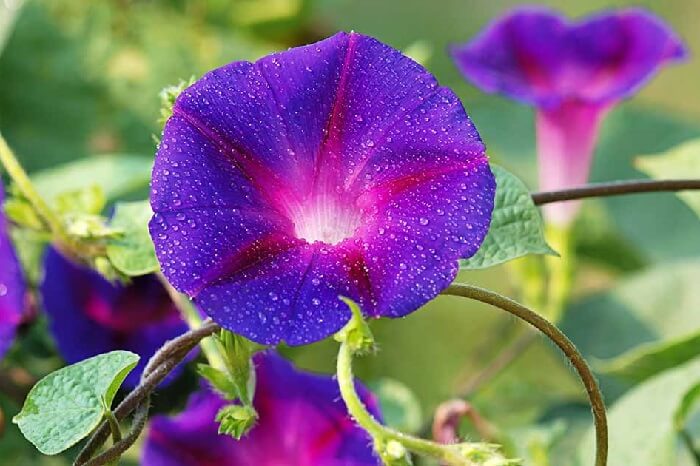The morning glory, also called morning glory and funnel wind, is a species-rich genus that grow in our gardens as climbing plants and delight with their diverse flowers and leaf shapes. They can be grown from seeds without any problems and reach a considerable size after just a few weeks. The bright colors that these plants conjure up in the garden during flowering are always fascinating and make the morning glory one of the most popular garden plants. Hopper winches, field winches and fence winches are among the most well-known species. Incidentally, the sweet potato, which is widespread in America, is also one of the morning glories.
Table of Contents
Start sowing early
The morning glory is best drawn from seeds that can be obtained cheaply today. Especially on the Internet you can find a large selection of morning glory seeds, which are often offered very cheaply. For the best result, make sure to always buy fresh seeds that have a date printed on the bag. Before planting the seeds, it is advisable to soak them in water for about 24 hours. That way they germinate better. Here you can put together a colorful assortment and enjoy the multicolored flowers in summer. If you want to enjoy the magnificent blooms in summer, you should start sowing early in the house. Depending on the species, the first seedlings appear after five to fourteen days. The plants are very easy to grow if you follow a few rules:
- Sow in pots in a warm room from mid-March
- Bodemperatur ca. 20 Grad Celsius
- Plant around three seeds per pot
- After the tendrils have started, transplant into individual pots
- Provide climbing aids
Transplant only after the ice saints
The plant is sensitive to frost, so you have to make sure that you only plant it outside after the last frost. In any case, it is better to wait a few more days. When inserting it, you should make sure that the planting holes are dug large enough. Before doing this, the garden soil must be well prepared and loosened. The funnel winches should be set at an oblique angle to the wall. The morning glories are annual plants. So if you want to enjoy the splendor of the morning glory in the garden every year, you should start growing again in good time every spring. You can change the color combinations again and again and thus give the garden a new, magical image.
Care over the summer

The morning glory needs very little maintenance. This beautiful climbing plant can reach heights of up to three meters. From June they bloom in light blue, red, pink, purple, light brown or white. Today you can also get a number of filled varieties on the market. Care is roughly the same for all varieties:
- Plant out in mid-May at the earliest
- Sunny location
- Normal garden soil, enriched with compost
- Provide wind protection and climbing aid
- Monthly fertilization with mineral fertilizers
The undemanding plant thrives excellently in any garden. Especially in a sunny location, it will bloom abundantly. The plant also thrives in partial shade. However, if you want a particularly profuse flowering, you should enrich the soil with mineral fertilizer once a month. Potassium-based fertilizers, in particular, promote the plant’s willingness to flower and contribute to the brightly shining flowers. The young plant should first be tied to the climbing aid. It is also important to water the plants regularly, especially during a dry period. You can watch the daily flowering rhythm wonderfully in the morning winds. Early in the morning the flowers open to their full splendor with the first rays of sunshine.
But in the afternoon this blossom has already faded again. The next morning a new flower takes its place and the spectacle begins all over again. Bindweed flowers and leaves are delicate. Therefore they are less suitable for very windy locations. It is advisable to create a windbreak for the plants. Climbing aids can be designed in different ways and you can also let them tend to such grids that are also used for other plants. Morning glory is also excellent in combination with other plants. The blooming of the winds delights gardening enthusiasts well into September. Since the plants are annual, they are simply pulled up and composted in autumn.
A cool, wet summer is an enemy of the morning glory, even with the best care. It blooms poorly and does not develop the wonderful sea of flowers that a sunny summer produces. It is therefore advisable to position the morning glory so that it can take advantage of every ray of sunshine.
Is the Morning Glory Poisonous?
The morning glory should be handled with care as it is poisonous in all parts. It contains lysergic acid amide, which is similar to the poison contained in ergot. Particularly dangerous are the fruit capsules, which contain the seed, which is where most of the poison is concentrated. The following parts of the plant are poisonous:
- Fruit capsule
- Together
- To a lesser extent: stems, leaves, flowers
Morning glory poison can be dangerous to young children or pets. The poison only takes effect when the parts of the plant are eaten. In this case, strong visual and auditory hallucinations can occur. Therefore, small children should not be left unattended near the plants and pets, such as rabbits, which could possibly eat the fruit capsule, should be kept away from the plants.
Using the funnel winch
There are many places to use for the morning glory in the garden but also on the balcony and terrace. The climbing plants are in principle suitable for climbing up any climbing aid. They serve this purpose:
- fences
- Maschendraht
- walls
- Pergolas
- Trees
- trellises
The plants spread out very quickly to form a wonderful carpet of leaves and flowers and offer excellent privacy. They are also suitable to hide unsightly surfaces and to wrap the garden in a summery garb. If you let them cling to a pergola or a small garden pavilion, the result is a particularly romantic atmosphere in which you can spend many wonderful hours in summer. The morning glory can also be used very well as background plants. They get along excellently with other plants and make a very nice combination, for example, in connection with climbing roses.
Morning glories, however, can also be planted in a number of other ways. There are no limits to the gardener’s imagination. Here are just a few examples:
Combined with underplanting
If funnel winds are on trellises, they can also be combined with pretty underplanting. Tagetes add wonderful splashes of color. Yarrow underlines the romantic character of the winds, and dahlias or gladioli also look great when planted under the magnificent twining winds.
It’s always a good idea to include plants in your underplanting that will bloom well into fall. So you can enjoy the flower combination for a long time.
Ground cover
The morning glory can not only grow in height, but also in width. If you are looking for a beautiful, blooming ground cover, the morning glory is also ideal for this purpose.
Morning
glories are also excellent as balcony plants on the balcony or terrace. Here you can take advantage of the fact that they grow very quickly. So you can put on a wonderful privacy screen in a very short time. On the balcony or where no bed is available, the magnificent winds can also be planted in open containers. They can also be planted in large boxes, where you can attach the trellis for tendrils.
Planted
hanging Another nice idea for the magnificent winds is hanging baskets. In such a basket, the plant will delight you all summer long with cascading flowers and leaves that pour over the hanging basket.
In mixed
beds If you want to use the magnificent winds to bring a little color into mixed beds, you should let them climb up on high posts protected with wire. Otherwise they will spread all too quickly over the entire bed.

Morning glory pests and diseases
- Red spider – Every now and then, the leaves of the bindweed are attacked by what is known as the red spider. The larvae of these spider mites suckle on the leaves. They reach a size of 0.3 to 0.6 millimeters and can therefore hardly be seen with the naked eye. The infected leaves roll up and die. Eventually the whole plant can die off.
- Whitefly – The whitefly also likes to choose the magnificent winds as a target. This is a small type of louse with wings that prefer to suckle on the underside of the leaves. The leaves show yellowish discolored sucking points. Eventually they dry out and fall off. The whitefly also moves from one plant to the next with ease, so if you discover an infestation it should be controlled as soon as possible. There are various insecticides for this. The treatment works best when it is repeated a few times at intervals of three to four days to kill resistant larvae as well.
Biological methods of pest control
Today the natural way of pest control is often preferred because it is more environmentally friendly and also less interfering with the biological balance in the garden. The use of beneficial organisms such as the predatory mite is ideal for this purpose. These eat the pest larvae without harming the plant themselves.
Make simple climbing aids yourself.
If you don’t have the opportunity to let the morning glory cling to a fence or similar existing scaffolding, you can create a climbing aid yourself with a little imagination. A light frame can be made quickly from wooden strips or bamboo. If you want to make it even easier, you can simply stretch wire or cord. These can then be removed again particularly easily in autumn. If you use natural fibers such as hemp, jute or coconut, you can even add them to the compost together with the plants in autumn. There is hardly any need to pay attention to the beauty of the scaffolding. It is soon covered with thick foliage and is no longer visible.
Conclusion
The morning glory is a climbing plant that has won the hearts of garden owners. It delights the viewer in summer with a wonderful sea of flowers. The plants are easy to grow and care for, so they can easily thrive in any garden.

